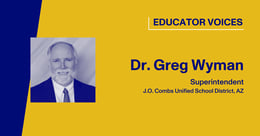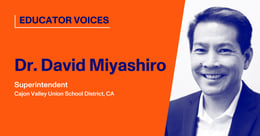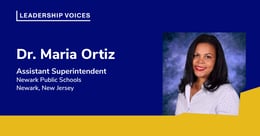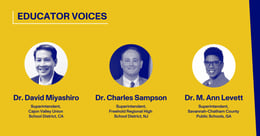
Dr. Donna DeSiato: “Time is the variable, learning is the constant.”
5 Questions with Dr. Donna DeSiato
Dr. Donna Desiato has been overseeing the East Syracuse Minoa Central School District, NY, for the past 16 years. During this time, Dr. DeSiato’s forward-thinking, innovative and passionate leadership has made her district a model for others across the nation.
The Paper team recently had the pleasure of sitting down with her and asking about her exemplary leadership. She generously shared how she supports extended learning opportunities, fosters a safe and collaborative environment for students and staff, and incorporates student voice and choice.
How do you support extended learning at East Syracuse Minoa?
Our vision is to become an exemplary 21st-century learning community whose graduates excel in a complex interconnected changing world. We certainly are living in a complex, interconnected changing world. And so, wanting our students to excel in all areas is really at the forefront of our thinking.
We believe that time is the variable and learning is the constant. And if we put things through that lens, we can alter time. Rather than compartmentalizing time, we can begin to look at time as being more fluid. We can permit students to go beyond the boundaries of what we would see as a traditional school day.
One of the major areas for us has been STEM. We were nationally recognized at the White House in 2015 for becoming a STEM learning ecosystem.
What does a STEM learning ecosystem consist of?
In an ecosystem, you have before-school and after-school types of learning programs and summer programs. We've cultivated that for multiple school years. So when we came into a COVID environment, we already knew we could go beyond the traditional boundaries.
We just held summer learning, and it's a type of extended learning that invites and celebrates both enrichment and acceleration. We're not trying to fix students. We're not trying to repair them. We're building on their strong foundation. We're building on what they already know and providing a learning environment that is a culture of trust, and a safe environment in which one can explore, take risks, make mistakes, and learn from those mistakes.
I was born into an Italian American family—my mom graduated from high school, and my dad made it to 11th grade and left to fight in World War II. And yet, they both believed so strongly that education was a key. We grew up on The Little Engine That Could, and that's why I truly believe that students have to believe that they can be all they desire to be.
In the Syracuse article we read, you said, "Leadership is not about power and control. It's about sharing whatever one may perceive to be power." As a superintendent, how do you distribute power to others in an effective way?
I don't see being a superintendent as having power and control. I see it as having a responsibility to have the accountability and the authority to be leading a system. Within the system, we have many different roles and people who ultimately comprise our community, and they are going to be the people with whom we will celebrate success.
It's crucial to have a strategic plan that identifies well beyond me as a superintendent. It's about engaging stakeholders in the development of our plan by asking, "What are the steps we're going to take?" and educating them into, "What are those challenges we have that have held us back in being successful as we could be?"
Einstein says, "You can't solve the problem at the same level at which it was created." And so what we have to do is understand: What capacity do we need to build? Is it learning? Is it capacity, structures, and systems? Is it capacity in the framework of the way that we're designed? Once we know that, then to me, it is about a distributed type of leadership—a servant leadership.
I continuously ask myself, "How will this decision impact students, their wellbeing, and their learning?" The day I became superintendent, I wrote this question on a little post-it note that I still carry with me. Every single decision must be made through that lens.
How do you incorporate student voice in your district?
When building our strategic plan, we asked students, "What are our untapped resources?" They replied, "We are." And they were so right. Students are born into a next-generation that we have to understand better. So having their voice and giving them choice has become a part of the fabric of our strategic plan.
When we were working on the first five pillars of our strategic plan, the "academic excellence and rigor" team discussed the potential action steps. One of the adults at the table said, "Well, not every student is going to go to college." And, again, our vision says to be prepared to excel in a complex interconnected world—it doesn't say what you're going to do, but it says you're going to excel.
And one of our juniors at the time said, "But that should be our choice and not someone else's decision." That was a very powerful statement. And when you have student voice at the table and hear their lens, you understand that you cannot be making choices where kids can't reach a greater degree of potential.
Would you like to highlight any other academic initiatives at East Syracuse Minoa?
For years in New York state, students with disabilities can stay in school until they're 21 years of age. A few years ago, one of our high school special education teachers shared that at graduation time, his high needs special education class with 18 to 21-year-olds ask, "Mr. McCoy, when do I get to graduate? When do I get to go to college?"
We have a college—Le Moyne College—that is about a mile away from us. We asked them, "What if our students were shuttled to your campus every morning, along with their teachers and support systems, and they had a space on your campus?" Our special education students engage in a lot of hands-on learning. So they might work in the library, the business office, the cafeteria, the recreation center, whatever it might be. So, we developed a plan called New Heights at Le Moyne. And every morning, those students are transported to the Le Moyne campus.
Think about it, if you're an 18 to 21-year-old, you begin to wonder, "Why am I still in high school?" And if you're the parent of an 18 to 21-year-old, you also wonder, "Why am I still having to explain why my son or daughter is still in a high school environment?"
This way, we're meeting their needs with all the nearest state learning standards and beyond. It's been amazing to see Le Moyne College campus adopt them and to see how proud our students are to be on a college campus now. I believe that an important aspect of leadership is being able to model taking risks. If we don't take risks, we'll never know what we could do for all students.
This interview, edited for clarity and length, is part of a series with educational leaders to highlight their perspectives on the changing realities of education.


-1.jpg?width=260&height=136&name=Educator-Voices-Terrence-Davis-Dr.-Ebon-Brown%20(1)-1.jpg)



